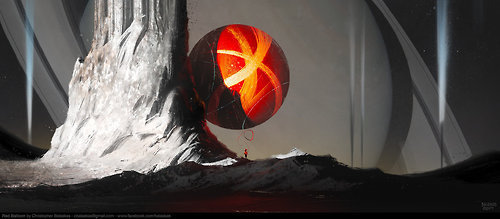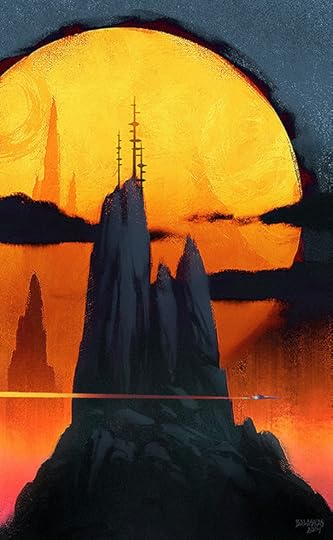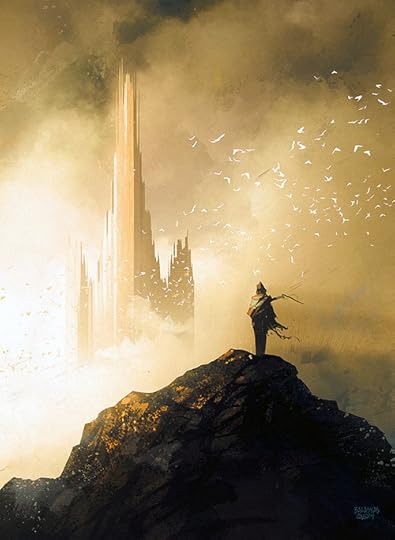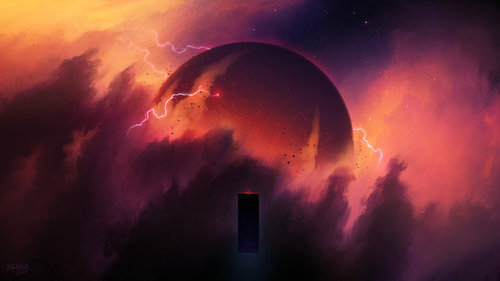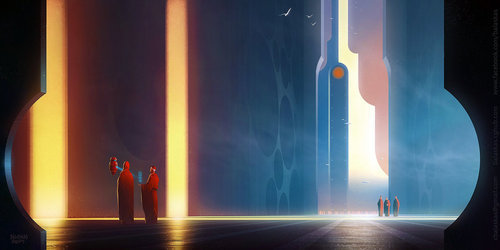C.J. Moseley's Blog, page 142
September 22, 2014
awesomedigitalart:
Custom Abstract Brushes by…
Custom Abstract Brushes by CGPaintings
Another great art brush package.
September 21, 2014
World-building 104: The Lay of The Land
[caption id="attachment_12552" align="alignleft" width="300" class=" center "]
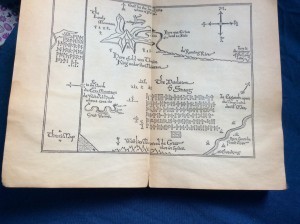 The map that pretty much started it all.[/caption]
The map that pretty much started it all.[/caption]No, not the map...
The world itself. We are going to discuss the Geography of the unreal. Whether we are talking about alien worlds from science-fiction, scary other-realms in horror or the delightfully recognisable worlds common to fantasy, there are forces at play in these places that go beyond the needs of the story, at least if you do it right.
And then I'll talk about the map.
Worlds and Otherworlds
In order to get through these posts on World-building I have to occasionally define what sort of world I'm talking about. In this particular post I'm concerned with the actual geography of the story/gameworld. This could mean:
An actual planet, just like Earth, Mars or Lesneelaf (Garner's homeworld in the Paradox War trilogy). In general these are big balls of rock, liquid and gases that hang around stellar systems and have physical rules that govern how they behave and what they look like. If you are making a physical world then you won't want to mess about too much with the Fundamentals, as you can quickly make an unbelievable world by simply forgetting to include friction, pressure, plate tectonics, temperature or those changes you made to gravity, chemistry or the speed of light in your concept of the world.
A realm removed from the planet as a whole, which operates much like a pocket universe off the main one. This is quite common in children's fantasy, where worlds hide in wardrobes, paintings, over rainbows, beyond oceans, down rabbit holes or through mirrors all the time. In these 'realms' the normal rules of geography need not apply, and you can muck about a lot more.
An underworld or spirit world, that exists alongside or beneath the real world. Quite common in mythology and religion, these realms don't necessarily obey any rules of physical existence, but do often seem to somehow mirror the real world, in which case you might want to think about the geography as an exaggerated form of the real world, hills become mountains, ponds become lakes, streams become mile wide waterways, etc. Of course some are just firey, sulphurous caverns beneath the ground.
Constructs and artificial worlds. These things, be they Dyson spheres, ringworlds, space stations or the Matrix are created by beings (in story characters usually called Architects or Builders for obvious reasons). They generally do obey rules, but they need not be the rules that natural worlds obey. Choices in constructs are often aesthetic rather than natural, but its okay because the architect should have balanced the physical and material engineering needs against the aesthetic choices, so the water doesn't just flow off the edge or whatever.
Climates, Regions and Biomes
There is nothing in science-fiction that screams unreal like the single biome planet. Whether its a world that is all hot desert, all forest or all ocean, it just seems unlikely to exist, and especially unlikely that life could survive there. Sure, there are great examples that appear to break this rule, the planet Arrakis in Frank Herbert's Dune seems to be a desert planet where life couldn't evolve, but the details of the world include hot desert near the equator and cold desert near the poles. The water on Arrakis is locked up by the lifeforms that have evolved on the planet. They did not evolve on a desert world, they made the world a desert. That makes it believable, where as we get nothing like that sort of complexity in Star Wars, where the planet Tatooine seems to be cooked by two suns and have no water, but still has indigenous life forms (that look like amphibians in at least one case), but only animals as far as we’ve seen.
[caption id="attachment_12675" align="alignright" width="300"]
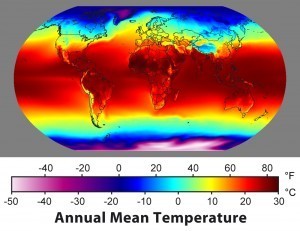 Check out how the temperature varies across earth[/caption]
Check out how the temperature varies across earth[/caption]In fact, the Star Wars universe seems to only have single biome planets (and forest moons), which may mean that in that Galaxy far, far away the Fundamentals were very different, long, long ago, or that George Lucas simply thought about planets as locations, Tatooine is Tunisia (and suspiciously close to Tataouine) with a bit of Death Valley thrown in (in ‘Return’), Hoth is Norway, Endor is the Skywalker Ranch’s backyard, etc.
Real worlds are rarely like this, (alright Venus is, but there is nothing living there, as far as I know) think about Earth for a moment. The average temperature varies quite a lot from equator to poles, and also varies depending on how far from the ocean you are. Just look at the image to the right. You can see a huge variation in temperature that also includes cooler temperatures at higher altitudes and warming ocean currents.
Temperature is very important to a world. Cold air is less energetic, it holds less water and can be very dry. Warm air on the other hand can store more water, but is more energetic and much more likely to form a storm, what's more the storm will be more powerful the more heat there is available to drive the storm. Temperature directly affects pressure and drives currents in water and in the air, pushing the jetstream around, which has further impacts on climates in a region. Currents in the North Atlantic keep northern Europe warm and wet, but deny North Africa much of the rain that it should have.
On Earth we can break the climate of Earth up into types that occur in certain regions. Across Earth we find certain regions have similar plants and animals, we call these similar 'communities' biomes. Earth has five or so biomes, which are generally given as Aquatic (although deep and shallow vary), desert (low rainfall, not necessarily warm), forest (where trees grow, often high rainfall in the case of rainforest), grassland (which has varied rainfall, and includes Prairies, Steppe and farmlands) and Tundra (where its generally cold and rocky), although Swamp/Marsh is sometimes included as well.
Oceans and Continents
Oceans are defined as large bodies of salty water, and are often divided into seas for purely identification purposes, since Earth actually has only one Ocean which is unbroken around all the islands above it. This may not be the case on other planets (and has not always been the case on Earth either), where inland oceans may be possible. On Earth we have inland seas that are separated from the global ocean on some continents, but they are usually classified as saltwater lakes. The land on Earth does do a pretty good job of breaking up the global ocean, so we can point out differences between the Arctic, Atlantic, Indian and Pacific oceans, the separation of North and South on the Oceans is largely for identification purposes as there is little to separate the North Pacific from the South.
[caption id="attachment_12682" align="alignleft" width="300"]
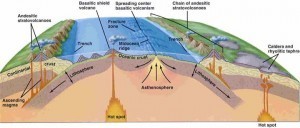 Thinking about plates can help you locate mountains and volcanoes[/caption]
Thinking about plates can help you locate mountains and volcanoes[/caption]Continents are more difficult to classify, they are large bodies of land that rise above the Oceans, but there is debate as to how many Earth actually has with the numbers varying between 4 (America, Afro-Eurasia, (Indo-)Australia, Antarctica), 7 (North America, South America, Africa, Europe, Asia, Australia and Antarctica) and 15 (The tectonic plates - although this number ignores the tertiary plates that the larger plates are made of). I generally think for world-building the actual Tectonic plates are the best way of thinking about the world.
Tectonic plates are lumps of rock floating on a molten core, they move and grind, creating earthquakes and mountain ranges (including volcanoes) and pull apart, creating rift valleys, seas, and more volcanoes. You can do a lot worse when designing a world than start with some simple shapes and then decide which way each one is moving to create some mountain ranges and island chains. It can certainly make for a more realistic world than just randomly drawing some island shapes on a map.
Land Go Up, Land Go Down
When continental plates crash together fold mountains are formed, the speed they rise depends upon the momentum of the plates in collision. Huge plates that are moving quickly raise the highest mountains (I'm looking at you India), but the tallest mountains (Hawaii) are not made this way, instead the lava from a volcano simply piles up into huge stacks.
Fold mountains often lift and expose rocks that formed in ancient seas, or from layers of basalt from ancient lava flows, which can mean they have obvious strata that show the immense forces that bend and spindle the land under our feet. If you want to have fossils, limestone, salt and flints to be far inland then these are usually formed in ocean beds and lifted in fold mountains. The pressures and heat beneath the crust can cause rocks to change and fuse, so you can end up with limestone being compressed and cooked into marble, perhaps one day a mountain range will rise above the current location of the mid-Pacific gyre that will include compressed and cooked plastics in a new form of rock. Pressures in these folding mountains can cause veins of metals to flow into cracks and voids in the rock, especially as many of the ores are also created on the sea floor, through ore genesis processes.
[caption id="attachment_12688" align="alignleft" width="300"]
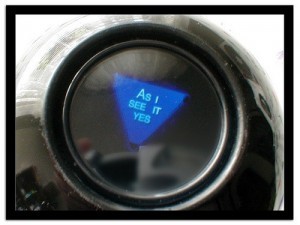 Magic 8 ball, if the Earth shrunk to the size of you, is it true the plates would seem to join seamlessly?[/caption]
Magic 8 ball, if the Earth shrunk to the size of you, is it true the plates would seem to join seamlessly?[/caption]It is perhaps worth pointing out that compared to some planets Earth's current sets of mountains and trenchs are so tiny as to almost be negligible, in fact if you shrank the earth to around the size of a billiard ball (or snooker or pool - lets not be gameist) the Earth would actually turn out smoother than the real ball, and what's more there probably wouldn't be enough water on its surface to get your hands wet (but it might leave a damp spot on tissue paper). Mars by comparison would be a smidge bigger on one side and have quite a tiny (nearly 1%) lump where the solar system's largest volcano Olympus Mons was lurking, which might effect how it rolled, just a little.
Even the slight pear-shape (or oblate spheroid if you prefer) of the planet Earth is pretty negligible when compared to the size of the planet, it comes in as about a third of a percent of the overall. Which I defy anyone to spot on any ball (even the largest beach ball you may find). In short Earth is pretty much a glassy smooth marble, and unless you make bearings for high tech gadgets as approximately spherical as you might like.
Once a mountain range or single volcano has arisen (even the little amount they do on our marble planet) it has a dramatic effect on the climate around it. Volcanoes commonly spread ash, smoke and corrosive gases into the atmosphere, these can have a cooling effect downwind, and often increases rain fall (or snow if its cold enough). Mountain ranges cause winds to pass over the tops of them, which causes a permanent high pressure system with limited rain-fall in front of the mountain and a low-pressure area that is called a rain-shadow in the lee. Most of the worlds tropical rainforests lie in the lee of one or other of the world's mountain ranges. Including the Amazon basin, which is fed by the Andes, just as South-East Asia is watered by the Himalayas. There are other factors at work here too. High altitudes are usually cold, and moisture at these altitudes falls as snow and hail, which in time can build up into glaciers. Current climate change has placed almost all the glaciers into retreat, which means they are melting, releasing their waters in cascades down the mountains, which also helps feed forest and grasslands across the globe, but there are a few (estimates are between 11 and 1000 world-wide depending on how rigorous your science is) that are still growing, and even these release melt-waters ahead of the glaciers.
Mountains basically are part of the water cycle. they attract moisture and release it from the atmosphere, so that it can return, via rivers and plains to the seas once again. All that water, pouring on the mountains has its effects though. Water dissolves and erodes rocks, breaking those mountains down, creating caves and gorges, huge, sharply-pointed mountains become rounded, hills in time, surrounded by rolling plains of soil and silt. If the mountains are suitably volcanic, or were once part of the right sort of sea, the soils created will be highly fertile, rich in minerals.
Dangerous When Wet
[caption id="attachment_12779" align="alignright" width="300"]
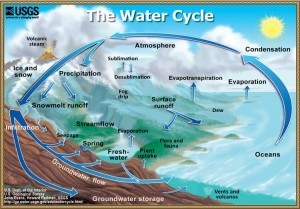 If you want rivers, storms, trees and all manner of useful things, you have to keep the water cycle cycling.[/caption]
If you want rivers, storms, trees and all manner of useful things, you have to keep the water cycle cycling.[/caption]As important as mountains are to the water cycle, water is important to the landscape. Glaciers and rivers carve and erode the land, the seas are constantly nibbling inland too. On Earth we have the essential Hydrological cycle that keeps the rivers running.
Water forms lakes in suitable depressions in the land, and if large enough, and warm enough, the water can evaporate from the lake at the same rate or faster than it fills, which causes the water to turn salty (from dissolved mineral salts) and can form a salt-lake (or inland sea), and in time may form a salt-flat. Salt lakes are quite common on Earth (there have been some enormous ones in the past). Most lakes however are simply a slightly deeper, slightly wider part of a river and empty at the opposite end to where they fill.
Rivers (and their cold cousins glaciers) carry silt down from the mountains across the landscape, they drop the silt in the slow moving parts of the river (like the inside of river bends) and pick more silt when fast-moving (like the outside of a bend) which over time causes the river to change shape and creates a river valley (glaciers tend to be more direct and create steeper sided valleys), it can create oxbow-lakes as curves are cut free from the river entirely. When the river is particularly large and heavily silted it tends to create a river delta at its mouth. River deltas are usually highly fertile areas, and are often amongst the first places that people tend to inhabit.
The actions of waves and tides is constantly gnawing at the base of cliffs around the coastlines of all the continents. In some places the rate of gnawing is fast enough that you can almost watch gardens and houses fall into the sea, but usually on average the coastline is fairly static. Storms and tsunamis may suddenly take a section of a cliff or drag a low lying loose soils and sands out to see, but the processes of water erosion (from river and sea) are gradual processes that change the outline of an area slowly. Still though when huge bodies of water are released at once they can wreak massive changes to the landscape (the Badlands in Montana seem to have been created in a few hours when a wall of ice collapsed and released Megalitres of water across the North-west of America), also as landscapes alter river valleys and gorges can change how they are used by water. An example may be the Grand Canyon which some geologists believe was carved in the opposite direction to how the Colorado river now flows, as the land has risen in the meantime.
A Living World
There is a big difference between Earth and Mars, some of that is down to the thickness of Earth’s atmosphere and the functioning water cycle, but there are signs that early on Mars had both of these things. The biggest difference is the lack of life. Life smooths the rough edges of the worlds, it accelerates the formation of ocean mud, and rock erosion, as plant roots tear apart the valleys around the rivers, but also slow the after erosion and divert the rivers.
Earth has about as many impact craters as Mars, but top-soil and tree canopies smooth them practically out of existence. This is why on Earth the most famous craters all occur in deserts, where they are easily spotted.
Cartography
So now you have a broad understanding of how Earth works, and you might even be able to see how that fantasy world you want to build might work. So the next thing to do is draw the map.
Personally, I tend to draw my maps on paper by hand, but there is something to be said for building your map on computer (a vector drawing package as Illustrator or Inkscape can be preferable as vectors print better, but any modern graphics package will work) where you can build in layers, perhaps first drawing the tectonic plates then adding a layer for the continents, with another layer for the rivers and lakes, and another for sea water. You can then even add layers for the cultural aspects, like the most common languages, demographics, cities, roads, railways, economic produce, architectural styles, etc.
[caption id="attachment_12691" align="alignright" width="228"]
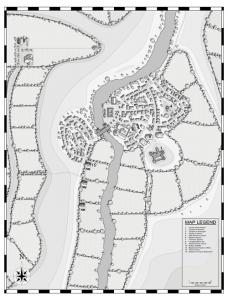 Campaign Cartographer 3 not cheap, but dedicated[/caption]
Campaign Cartographer 3 not cheap, but dedicated[/caption]There are a number of great Cartographic resources and software for budding world-builders, if you have plenty of money you can get real professional software for map building, and many GMs and DMs like ProFantasy’s software, which is a pretty good option, Fractal Mapper is another example.
If you want to go for a free option, you may be out of luck these days (although doing a search for “free open source fantasy map cartography software” might be a good start) and links to these sorts of resources are rarely stable.
There are a number of good websites and resources that can produce fractal worlds and terrain, which look pretty close to a real world (although they tend to ignore the processes of erosion and can rarely include the effects of life on the planet), and some people seem to like them, but I’ve always thought that they aren’t actually as good as using a good graphics package and perhaps some clip art map symbols.
To map or not to map
So that's how you do it, but what map should you be drawing? Some authors and GMs have to start with the world-map and that’s fine, but totally unnecessary if you are actually only dealing with a story that is set on a single island or in a single city, in which case those are the maps you really want to get drawn.
I do like to have the world-map available so that I know where everyone in the story is actually from, and where in the world the story is set, but when gaming the players rarely get to see that. Instead the maps they buy/find tend to be a regional map which is just a tiny section of the world, and the location maps tend to be the ones I worry about most (the dungeons and so on in a game) as they are where the characters spend most of their time (so to speak).
Even when you have drawn a map, that doesn't mean you have to stick it in the book, or show it to your players. It has become a staple of Fantasy literature, and many fans expect a map, but you really only need to include it if it serves the story or the readers’ understanding of the story. Stories that are highly political (with multiple diplomats from various foreign countries), war stories and the like, or are essentially travelogues across the map in question, probably do need to include the map, but if you are just trying to lift a curse from a peasant village, the reader might not need to know where the nearest river is.
Well that's about it for the physical world. Next time I’ll post about the Eco-systems.
Always.In fact I read past every time.
September 20, 2014
vikingbooks:
You’ve been warned.
Consider me warned
September 19, 2014
retrogasm:
To some extent it’s getting that…

To some extent it’s getting that way…
Getting?
Let’s face it all politicians are often narcissistic ego-maniacs with little or no ability to empathise with the common man. They are by the nature of their job manipulative and deceitful, prone to antisocial behaviour (especially with regard to the opposition parties) and have diminished empathy and remorse for those lives their decisions ruin and destroy. Pretty much textbook psychopathy.
In fact the one thing that seems to guarantee someone should not be in charge is the fact that they want to be. We’d probably be better off picking candidates by a random lottery. At least then we may have something like a balanced argument.
September 18, 2014
geewizzard:
by Balaskas
Wow, pretty
September 17, 2014
qorthos:
Town of Kingsford
Made with Campaign Cartographer
A…
Town of Kingsford
Made with Campaign Cartographer
A nice roleplaying / world-building resource right there
World-building 103: The Fundamentals
World-building 103: The Fundamentals
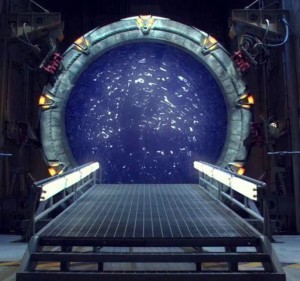
In the first post I talked about the features you need to think about for a world and then I talked a bit about the planning and process. This post is about what I like to call the Fundamentals. Fundamentals are the broad rules of the world, they govern the physical rules of the universe, like how the rules of physics work, what chemistry/biology functions and what the rules of magick are (if…
World-building 103: The Fundamentals
Physics
Science-fiction is adept at bending the rules and exploiting the loopholes of physical laws. There are two ways to go about breaking the rules of science, the soft way, and the hard way.
[caption id="attachment_12608" align="alignright" width="300"]
 It’s okay we don’t have to explain the exotic particles necessary to open and stabilise a wormhole because the Ancients did it.[/caption]
It’s okay we don’t have to explain the exotic particles necessary to open and stabilise a wormhole because the Ancients did it.[/caption]In soft science-fiction it is enough to simply state that a rule can be broken, you can cite alien or ancient technology and move on. Time has a way of turning hard sci-fi into soft sci-fi as new discoveries make the theoretically possible actually impossible, and vice-versa.
In hard sci-fi the science has to at least sound plausible, so unless you seriously know your stuff (at least search the internet to see if anyone has come up with any theoretical way of breaching the law in question, you don’t necessarily need a higher degree in physics or engineering), then don't go there. If you have some training in a science or engineering subject then you should be able to identify the laws you want to bend, mutilate and break and work out some theoretical way of doing that, even if you have to invent a new stable super-heavy element or exotic particle (let's face it with dark-energy and dark-matter out there, the truth really does seem at least as strange as fiction)
Most movies and TV shows are mostly soft sci-fi. Some are harder than others, the writers on Star Trek just used to put in a slot for exposition and some poor engineers and physicists had to come along and write convincing hard science techno-babble to cover their butts — back in the nineties me and some friends wrote an essay on how cloaking devices worked, which you can still occasionally find quoted in wikis and the like, it even sparked off some later stories (as far as we can tell — I never got a credit) and got incorporated into memory-alpha because of it.
[caption id="attachment_12609" align="alignleft" width="300"]
 I guess the Empire had done their best to eradicate scientific knowledge of Midi-chlorians too.[/caption]
I guess the Empire had done their best to eradicate scientific knowledge of Midi-chlorians too.[/caption]However, the Star Trek universe had some real science underpinning the baloney (at least until the reboot) even if terms like “Heisenberg Compensators” were bandied around, Star-Wars by comparison is so soft it has the rigidity of soup. In fact it hardly qualify as science-fiction at all and is more science-fantasy. Anytime real physics terms are mentioned they are used incorrectly (and no amount of fudging later will convince us that Han or Obi-Wan knew what a Parsec was or that Hyperspace uses length for time) and yet because of the existence of the magic, sorry psionics, sorry Force we are willing to overlook that and enjoy (at least until some idiot mentions midi-chlorians then all bets are off). Oh, and those are not the odds of safely navigating an asteroid field either.
In sci-fi (especially soft sci-fi) you can get away with using almost any device that a hard sci-fi author (extremely theoretical scientist usually) has ‘invented’ just by using the right generic name and never trying to explain how it works, this keeps the sci-fi universe ticking over with terms like, artificial satellite, hyperdrive (and hyperspace), wormholes, time-machines, laser guns, robots (and androids and cyborgs), anti-matter, anti-gravity, fusion reactors, force fields, psionics, mutations, tractor beams (available in gravitic, magnetic and acoustic flavours - mmh acoustic tractor beams), warp drives (and space and time warps), some of these I covered in my Science in science-fiction posts last year which you might find useful.
Of course, in fantasy lands breaches of physics are usually (except where the author just didn’t know) because a wizard did it… which I'm coming to, first though…
Chemistry
[caption id="attachment_12613" align="alignright" width="300" class=" "]
 One of the original glowing green rocks that had weird chemical properties, and also clashed so badly with capes and tights that it was almost deadly.[/caption]
One of the original glowing green rocks that had weird chemical properties, and also clashed so badly with capes and tights that it was almost deadly.[/caption]You find science-fiction and more normally fantasy has a lot of strange materials in it (okay so this one might be titled 'Material Science'. If you are going the way of fantasy authors you can call on materials like Mithril, Adamant, or Orichalcum to get you out of a plot-hole, although you’ll also find Fairy Steel, Star-metal and that weird glowing green rock.
Unobtanium, Phlebotinum, Neutonium, Ununpentium (or other transuranic metals), Kryptonite, Adamantium, Vibranium and advanced Nanotechnology materials (anything with Buckminster Fuller's name associated or described as diamond-age technology) are the versions you’ll find in modern science-fiction (and comic-books). For those retro-futurists you might like to think about gravity shielding Cavorite and similar materials.
But Chemistry isn’t just about the material science really, you can also think about drugs, potions, medicines that are unique to the world you are building. Whether its food-pills, invisibility potions, truth serums, zombitoxin, elixir of life, universal solvent, shape-changing-mind-altering Jekyll and Hyde tinctures, Ambrosia or the latest medical bio-glue, you can do a lot by throwing in a new chemical.
Chemistry can also affect the Geography and Ecology of a world, if an alien world has acidic oceans and rivers the rocks will be very different to those created by a pH neutral liquid like water, and the fish are probably highly acidic themselves.
Again you can use a soft or hard approach in science-fiction, do your research if you are going to bandy around terms like intra-atomic bonds, lattice structures, crystal alignment, or dopamine receptors (veering into biology by way of bio-chemistry there) it will pay off.
In fantasy it is usual to blame any wierd chemicals that turn up on ancient civilizations, an alchemist or that wizard, but it can be dragon’s blood, venom or the distilled nectar of a particular flower too.
Biology
[caption id="attachment_12617" align="alignleft" width="300"]
 What do you know, Weyland-Yutani had it right all along, it is a bio-weapon![/caption]
What do you know, Weyland-Yutani had it right all along, it is a bio-weapon![/caption]Biology in fundamentals has a lot of crossover with the ecology of a world (which gets a post of its own later). Changes to the Fundamental rules of biology, like adding a new mutant 'X' gene, acidic blood, or deciding that Darwin was completely wrong and we were designed by aliens might be okay in some fiction, but unless you really do the research it is never going to let hard sci-fi readers suspend disbelief.
The rules of evolutionary biology are perhaps a little more flexible than those of physics though, this is because while evolutionary biology has had its Newton in the form of Darwin it is yet to have its Einstein, and no one has yet explained how flying creatures managed to evolve not just once, but four times independently (and partial wings don't seem to have any purpose, except maybe as the grasping arms of raptors, 'display' purposes, or for self-hugging warmth, and most of those apply only to birds — although insects may have used them for making noise). Also effects like convergent evolution exist as well as wildly divergent evolutionary pressures, which muddy the rules still further, and the whole thing is complicated by trying to extract universal laws from a single data set (namely planet Earth).
In reality real xenobiologists (or biologists who think the right ways) are quick to point out that we might not even be able to recognise alien life as life at all, beings that lived on frozen moons may have metabolic processes so slow that we simply could not perceive them, viewing them as nothing more interesting than a rock, conversely a (presumably organised plasma) being that could survive on the surface of a star would live life so fast that we couldn’t hope to see them either. So when people talk about rules for biology, they are talking about the rules we have observed on earth and, as Star Trek put it, life as we know it.
[caption id="attachment_12619" align="alignright" width="300"]
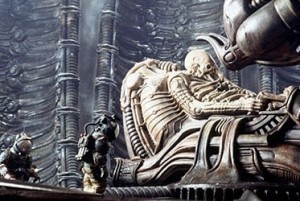 This weird alien, blended into the technology around it, yeah, that’s a suit.[/caption]
This weird alien, blended into the technology around it, yeah, that’s a suit.[/caption]This grants even the hard-science fictioneers plenty if room to manoeuvre when dealing with alien life, but even so it is worth thinking about how that parasitic-birthed-acid-blooded-xenomorph, or gestalt-polymorphic-retro-virus entity evolved, (or was engineered). The more thought you give to how they evolved the more interesting the aliens become, we spent thirty odd years wondering about the biology of the ‘space-jockey’ and its relationship to the Alien before Ridley Scott came up with some ‘answers’ of suit and engineered bio-weapon.
In fantasy fiction there is a lot more room to place with biology, hybrids can easily be knocked up by a wizard or passing deity a jiffy, that said the best fantasy (in my opinion) usually treats biology as having much the same rules as our world, creatures evolve and inhabit niches in the ecology, even dragons and unicorns can make sense in the world if you want.
I'll talk about monsters and population balance in my later post on Ecology.
Magic
[caption id="attachment_12621" align="alignleft" width="300"]
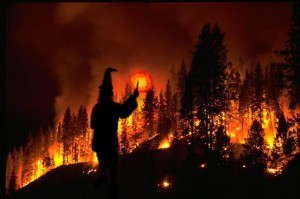 In Dungeons and Dragons for some reason all a Wizard’s problems start to look flammable once he’s reached Level 5.[/caption]
In Dungeons and Dragons for some reason all a Wizard’s problems start to look flammable once he’s reached Level 5.[/caption]Perhaps deserving of a whole series of posts in its own right (world-building 201 perhaps), but I’ll try to give you the quick guide to magic, as I see it.
Magic is a staple of fantasy, although early works tended to gloss over the details and systems, but after the release of Dungeons & Dragons in the 70s suddenly there were a lot more wizards in fantasy, and a lot more sense to the magic that was turning up. Gandalf the Grey hardly did any magic at all, in fact he was more like a deus ex machina with a sword, but later wizards in movies and books had much more to do and say, and by the time Hagrid told Harry what the owls were about we all had a very different idea what Wizard meant.
In an old post called Fantastic Magick I talked about my research into magic. So if you want you can read that to get idea where this stuff is coming from:
Common models for magic
There are numerous models for magic in fantasy. Here are some:
[caption id="attachment_12667" align="alignright" width="204"]
 Clerical powers may vary from world to world.[/caption]
Clerical powers may vary from world to world.[/caption]Spiritual Model: also called the Shamanism or Divine model, this supposes that the physical world is mirrored by a spiritual realm where supernatural entities (from spirits and imps to deities and demons) hang around. By imploring, bargaining with or cajoling these spirits the Mage can change the spiritual world, and the most powerful entities can change the real world for him. Common abilities: Communicating with spirits/gods, summoning spirits to possess objects or people, travelling into the spirit world, manifesting spirits into the real world. Common cost: spirits often require sacrifices and if the Mage fails to persuade or control the spirit then the magic will fail, or worse.
Energy Model: Also called the New Age, Arcane or Force model it supposes the universe is a seething mass of energies and potentials, matter is crystallised energy, and what defines the nature of that matter or energy is its vibration or waveform. Static matter has a stable waveform. A Mage (or Jedi) is able to feel and alter these energies, redirecting and reshaping them through tools and his own vibratory energy of his mind/life energy. This is the model used in D&D for their mages. Common abilities: Extra-Sensory Perception, Matter manipulation, Energy liberation and control. Common cost: The Mage may require objects to provide energy or resonate at specific frequencies, the Mage is often tired, the magic draining their own energy to alter others, can be deadly to the Mage if they are not of sufficient experience.
Probability Model: Also called the Fate or Luck model, it supposes the physical universe is nothing more than a mass of unlikely events, circumstances make some results more likely than others to any given action. By knowing the correct actions to take, the probabilities of certain results can be made more likely. Common abilities: Luck/Chance altering, Coincidental magic, Prognostication, Doom-weaving. Common cost: usually requires great concentration, years of practice and specific spells to perfect. Failure can result in wild and unpredictable results.
Belief Model: Also called the Maya model, the physical universe is nothing more than the collective beliefs of the people in it. If you can change what people believe then the world will change to match. Common abilities: Illusions and Glamours, hypnotic effects, sciences, technologies. Common cost: can require great concentration, and special preparations to alter the world. Often when it fails it will drive the Mage (or target) mad, making them believe the magic worked, when it did not.
Psionic Model: also known as the Personal Power or Will model, it supposes that the power of a mage's mind can alter the universe directly (similar to the belief model). Common abilities: ESP, Telepathy, Telekinesis, Mental projections, Poltergeist activity. Common costs: Usually requires aptitude and training to achieve more than the slightest effects, is always tiring for the Psionicist and may become erratic or uncontrolled when stressed.
Information Model: also known as Quantum Model which supposes that reality is mostly down to the information stored in it, like a book. A Mage can read information and possibly even write or rewrite information in the book. Common abilities: ESP, Telepathy, Prognostication, Psychometry, Matter and Energy manipulation and creation. Common cost: Difficult to control, can go disastrously wrong.
There may be more than these 6 models (perhaps a 7th shadow magic model exists, but if it does I'm as much in the dark as you) and they can be blended together, in fact “Real Magick” seems to use all of the above depending upon the nature/culture of the magician.
Laws of Magic
[caption id="attachment_12626" align="alignright" width="300"]
 Every apprentice needs a wizened mentor, some are more wizened than others.[/caption]
Every apprentice needs a wizened mentor, some are more wizened than others.[/caption]Every fantasy world seems to have laws for its magic. Sometimes the old wizened mentor will explain these laws and sometimes the wizard will discover them for himself. In some stories the whole point of the plot is for a character to discover all the laws of magic (Master Of The Five Magics by Lyndon Hardy).
If you have magic in your world, you should decide what the laws of magic are. You might have a list of laws in mind already in which case, great, or you might have none. Here are some examples of Laws of Magic you might want to think about:
Magic is undone by... Spilling the blood/Death of the Magician, true love, after a duration, or similar.
To target a spell a Mage must… know the target’s true name, have a symbolic connection to them, point at them with a wand, make eye contact, or similar.
Magic never works the same way twice.
Magic can only be performed through the use of set spells or rituals.
Magic can only happen while the Mage is concentrating upon it.
Magic cannot create or destroy anything, only transform or move.
Magic obeys the rules of entropy, the costs must be paid.
Magic cast out will return upon the caster three-fold.
Mages can only cast so many spells a day.
Magic is associated with specific genes or bloodlines, wizards are mutants or hybrids with magic using creatures such as fairies, dragons, immortals or gods
Magic is powered by the mage’s life force, each casting ages the caster.
Spells take up space in the mage’s mind, to learn a spell they must give up a (childhood) memory.
Magic is powered by the mage’s sanity, each casting increases the chances of insanity.
Magic requires a group, performing a ritual, which mitigates the costs and shares them out.
Certain spells can only be performed at certain times of the day, week, month or year.
It is easier to alter the mind than the spirit world or real world.
All spirits are actually evil and will eat the mage’s soul if they get chance.
Magic must have a vessel (you can make a flaming sword, but not throw fire).
Magic comes in elemental flavours, which interact in specific ways. Water opposes Fire, Earth opposes Air, etc.
Magic is not a science there is only a chance that any given spell will work.
Magic is just advanced science, it obeys all the rules of physics, chemistry and biology. The corollary is that the sciences are a subset or school of magic.
Magic is powered by mana (or similar energy) which each mage has only so much of a day or a lifetime.
Pick a few, or better yet make some up of your own.
Techniques and Tools of Magic
[caption id="attachment_12664" align="alignleft" width="300"]
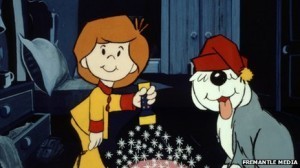 Some magickal tools are more stranger than others[/caption]
Some magickal tools are more stranger than others[/caption]What separates the magic of an Eskimo Angakok and a Blackfoot Medicine Man? Both are using the Shamanic model, calling on similar spiritual entities, but they do the same magic in very different ways. Here’s how you set that up for yourself.
A song, chant or poem (each effect/spell is different) which must be correctly pronounced.
Nonsense words (which might be in the song, or be the names of spirits that must be called upon)
Complex hand/wand/dagger/sword/staff gestures or dance
Writing/drawing runes/signs/hieroglyphs/symbols/circles/mandalas
Music must be sung or played that is specific to the task
A puzzle must be solved (usually a magic square, or mathematical equation - although I guess that's like engineering)
A specific potion, powder or poultice must be made during the casting
Symbolic objects are used in the casting of the spell, such as ropes, candles, chalices, cloths, bat guano, etc
The Mage must enter a trance or heightened emotional state to activate their magic.
You can make these techniques and tools universal, or require specific ones for specific spells, schools or magicians. It's your magic, set it up how you like.
The Price Of Power
Magic should have a cost, otherwise the mages are unstoppable beings that would destroy the universe for their petty whims. Some example costs you may want to think about including:
[caption id="attachment_12665" align="alignright" width="240"]
 Bat guano: essential ingredient for fireballs and gunpowder.[/caption]
Bat guano: essential ingredient for fireballs and gunpowder.[/caption]Physical ingredients are consumed in the magic, ink, gold dust, gems, incense, wine, spices, paper, chalk, candles, etc.
Animal (and perhaps human) sacrifices must empower the spells and rituals to work
The mage's life force, sanity, creativity, hair, emotions, memories, mana, willpower, or own blood must be sacrificed to empower the spells
Food and drink must be consumed during the rituals of magic that are appropriate for the spirits called
The environment will be drained of energy (mana, life force, heat, etc) by the magic
Risk, while not actually a cost the mage must risk it all when casting. If the spell goes wrong it may cost them their sanity, life, or immortal soul in one fell swoop
Backlash, magic has its effect, but then later the effect will Backlash affecting the mage or their environment negatively. This effect may accumulate over time.
Again you can pick one, or several and invent new ones for yourself. You can decide if every spell or effect has a different cost, or whether magical laws are universal, only the intensity varying. Personally I like to have differing schools of magic that all operate in slightly different ways to make for a deep complex magical world. This is similar to the real world where the magic practiced by Native peoples around the world may share similar concepts, but have completely different implementations. Australian Shamans are said to be close to the spirit world and are feared for their powers, the Shamans of Siberia are also close to the spirit world and feared for their powers, but the techniques, tools and restrictions on their powers are not similar at all, and both are different to a Spiritualist medium who claim the same closeness to the spirit world.
Summing up
Working out the fundamentals of your world (or rather how they differ from what you think of as the real world) is a great start to building a complex and realistic fantasy, horror or science-fiction universe (it can even help with historical novels, thrillers and detective stories). You can always state that your book is set in the real world, but sometimes that raises the question of which real world? The real world as seen by a Physicist is very different from that of a primitive shaman, and neither exactly line up with the world view of Hollywood actors.
Right well that about wraps it up for the Fundamentals, next time I'll talk about Map making (Cartography) and Geography, until then drop some comments if this was useful or you now want my blood...
September 16, 2014
thecyberwolf:Unlikely Trio (Sub-Zero + Link +…

Unlikely Trio (Sub-Zero + Link + Juggernaut)
Created by Billy Christian (Bill Creative)
/
Now that’s a T13 character group that would be fun to run for…


